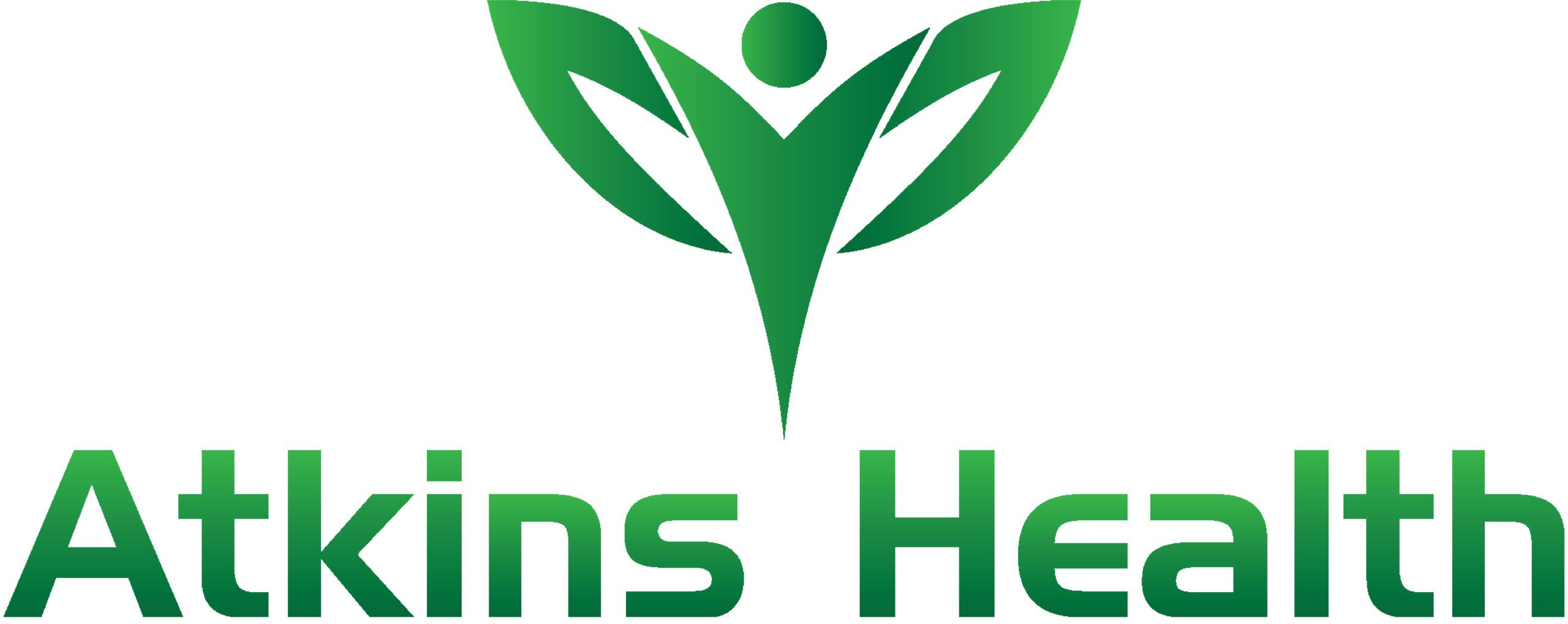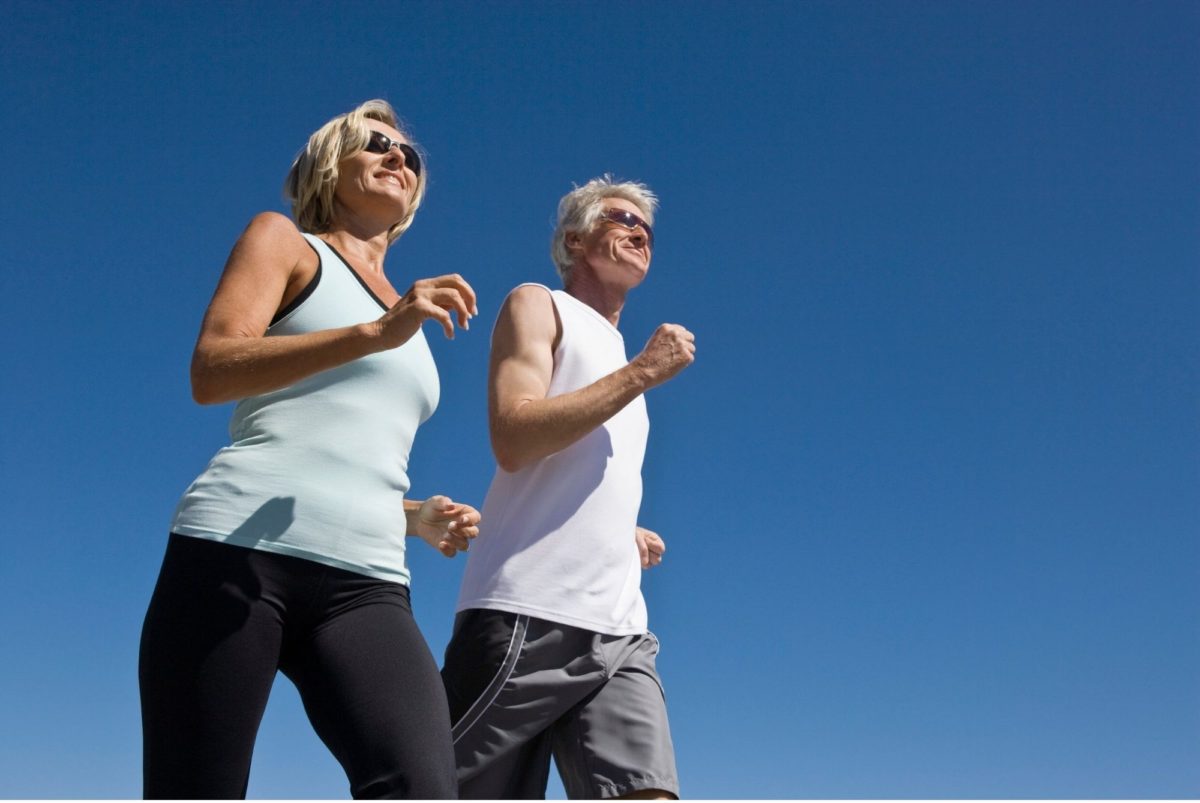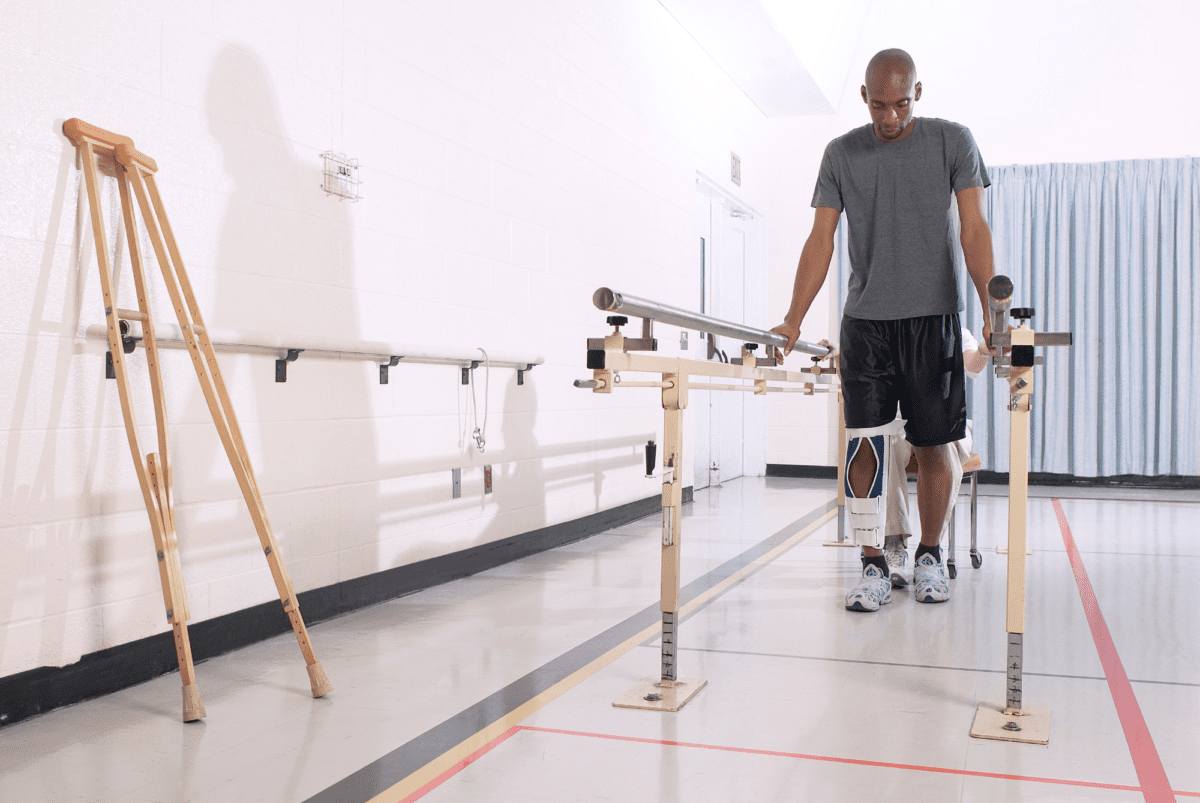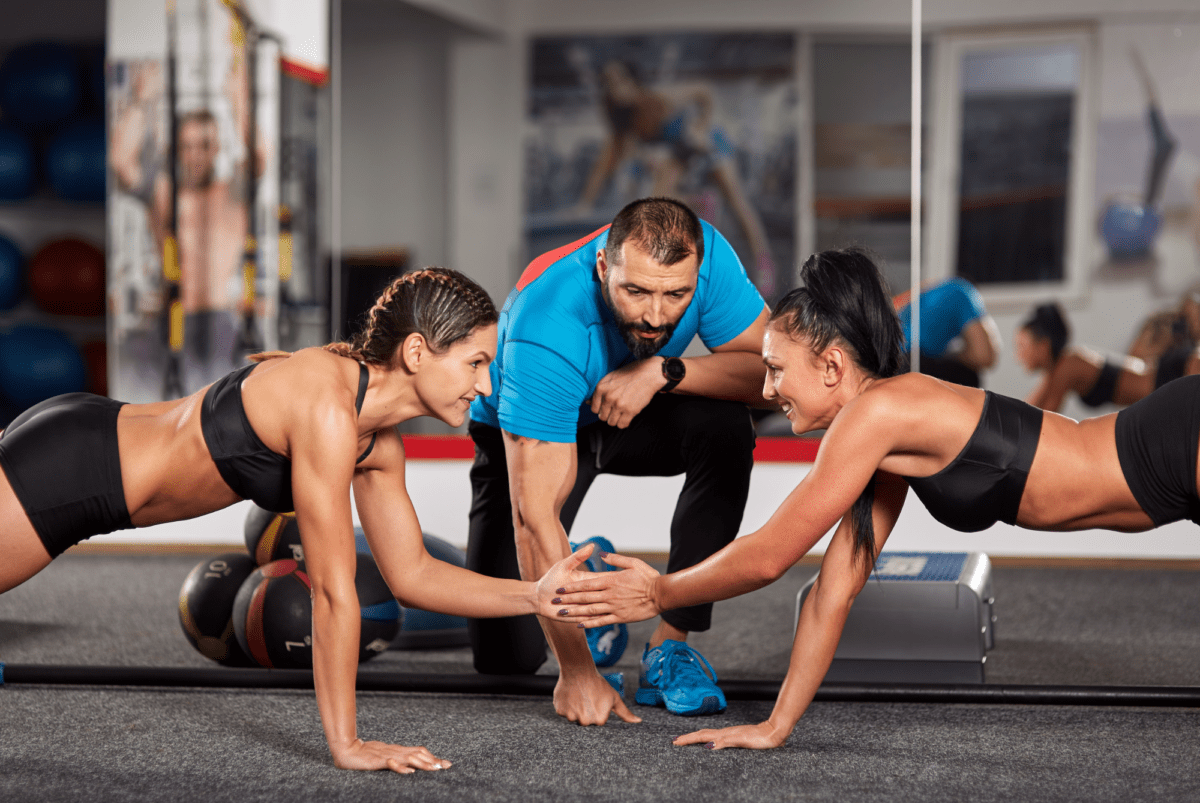Come and join Ben, every Friday morning in Robina for a two hour walking program, delivered in conjunction with Gold Coast Health to support the community with a monitored exercise routine.
Health Blog and Podcasts
Our team has designed this Multiple Sclerosis exercise program specifically focused on improving the mobility and lifestyle of those impacted by this neurological disease
Australia’s ageing population means that more Australians are getting hip replacements and the good news is that with improving surgery techniques and rehabilitation protocols, Australia has a high rate of hip replacement success. So, what are the keys to having heathy hips and successful hip replacement recovery? In this article we explore how the hips work, how to improve hip health and how to prepare for and manage hip replacement surgery and recuperation.
What are hips and what do they do?
The acetabulofemoral joint commonly known as the hip joint, are ball-and-socket joints located at the junction of the thigh bone and pelvis. They play a crucial role in various movements and are among the largest joints in the body, supporting a significant portion of a person’s body weight.
Hips enable a broad spectrum of movement in the legs, facilitating activities such as walking, squatting, jumping, ascending and descending stairs, sitting, and any other motion that requires lifting or lowering the leg. Ball-and-socket joints like the hips typically exhibit the highest degree of mobility among all body joints.
The hip joint enables various movements such as flexing and extending the legs, rotating them inwards and outwards, and moving them towards or away from the midline. Despite not having an extensive range of motion, it plays a crucial role in stabilising the connection between the upper and lower body.
The anatomy of hips
Hip Bones:
The bones are commonly known as the pelvis. Within the pelvis, two key components play a crucial role in the hip joint; The acetabulum serves as the socket where the upper part of the femur is inserted, while the sacrum provides support to the lower spine and acts as a connection point for numerous muscles and ligaments that help support the hips.
Muscles of the hip:
The muscles of the hip play a crucial role in both motion and stabilisation, with some performing both functions simultaneously. While over fifteen muscles contribute to hip movement, the following are among the largest and most significant:
The gluteus maximus muscle attaches to the ilium, the largest part of the pelvis, and the sacrum. Its primary functions include leg extension and external rotation. This muscle is crucial for actions such as rising from a seated position, running, and walking uphill. Additionally, it plays a key role in supporting the pelvis and enabling activities like maintaining balance on one leg.
The gluteus medius is the main muscle responsible for hip abduction, which involves moving your leg away from your midline. It also plays a crucial role in stabilising your knee when you need to balance on one leg temporarily while walking or running. Positioned between the gluteus maximus and gluteus minimus, the gluteus medius is essential for maintaining proper hip function and stability.
The gluteus minimus is the smallest muscle in the glute group, attached to the ilium. Its primary function is to assist with abduction, but its main role is to provide stability to the hips during these movements.
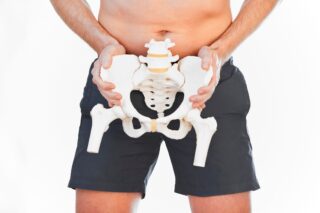

Pelvis Anatomy including the Hip
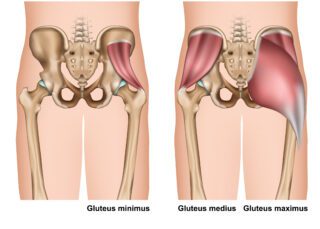
Gluteus Muscles
The psoas major muscle is a significant muscle that connects the spine to the inner pelvis. It plays a crucial role in linking the upper and lower body and stabilising this connection. Additionally, it connects the front of the body to the back. At the hip joint, the psoas assists in leg movement, hip rotation, and provides stability during subtle hip movements.
The iliacus muscle connects the ilium of the pelvis to the sacrum. It plays a key role in leg extension and external rotation.
The piriformis muscle attaches to the sacrum and plays a crucial role in lifting and rotating your leg. It is vital for redistributing your body weight when walking from one side to another.
Nerves of the hip:
The nerves located in the hip region play a crucial role in providing sensation to your legs and facilitating essential functions such as walking and everyday movements. These nerves encompass:
The obturator nerve which supplies sensory innervation to a part of the thigh and serves as a motor input for various crucial hip muscles.
The genitofemoral nerve supplies sensory innervation to the genital area and the lateral femoral cutaneous nerve supplies sensory innervation to the lateral thigh.
The femoral nerve supplies feeling to parts of the leg and controls the movement of the psoas muscle and other significant muscles while the posterior femoral cutaneous nerve supplies feeling to the rear of your thigh.
Sciatic nerve: In certain individuals, this nerve travels above the piriformis muscle, while in others, it goes through the muscle. It plays a role in the movement of your hamstrings. Read our blog about sciatica.
Indicators of potential hip issues
The hip joints are susceptible to both gradual deterioration and sudden trauma. If you experience hip pain or stiffness, these are typically the primary indicators that there may be an underlying issue with your hip. Contact a doctor immediately or visit a hospital emergency department if any of the following occur:
- You cannot move your leg or hip or you cannot stand or bear weight on a leg
- You have intense or referred pain in your hip or leg
- Your hip or leg looks deformed
- Your leg is very swollen or has become swollen suddenly
- There is redness around your hip.
Conditions affecting the hips
Arthritis is a prevalent hip condition where the cartilage in the joint deteriorates over time due to usage, leading to bone-on-bone contact, resulting in pain and limited mobility. Treatment options for hip arthritis typically involve physical therapy, anti-inflammatory drugs, and corticosteroid injections. In severe cases, hip replacement surgery may be a necessary option.
Bursitis is characterised by inflammation of the small sacs of fluid that cushion the joints. The treatments for hip bursitis are akin to those prescribed for arthritis. These may include anti-inflammatory medications, corticosteroid injections, and physical therapy. Lifestyle adjustments to avoid activities that aggravate the hip can also be beneficial. In cases where these methods prove ineffective, surgical removal of the affected bursa may be recommended by your doctor.
Avascular necrosis occurs when tissue in the hip dies due to a lack of blood flow, typically caused by injury or tumours. This can lead to the development of tiny fractures in the hip over a period of months or years, eventually resulting in bone breakdown. The primary symptom of avascular necrosis is progressive hip pain.
Ensure your hip health with these tips:
- Work on improving your posture and maintain a healthy weight
- Take breaks from prolonged sitting
- Strengthen your core muscles, including your glutes
- Avoid high-impact exercises initially and opt for lower-impact movements
- If you experience pain in your hips, rest and ice packs may provide some relief, but don’t delay in seeing your doctor if pain persists
- Early intervention is key to preventing potential complications in the future
Hip replacement surgery rehab and prehab
Re-hab
Physiotherapy following a hip replacement can expedite your recovery process. Ideally, it is advisable to consult with one of our physios prior to surgery as well. Physiotherapists are valuable in overseeing and supporting the rehabilitation journey post hip replacement. We develop precise evaluations and personalised programs that align with your functional capacity and facilitate the accomplishment of targeted objectives in a secure and effective manner.
Pre-hab
Physiotherapy before undergoing surgery helps to ensure that you maintain muscle strength and range of motion in your joints. Referred to as pre-hab, this practice has been shown to reduce complications and enhance recovery outcomes.
Through pre-hab, you will be educated on movements to avoid post-surgery and be introduced to targeted strengthening exercises for the muscles surrounding the hip joint. Hydrotherapy, which we offer at our Runaway Bay clinic, may also be recommended, offering a beneficial way to experience movement, alleviate pain, and potentially facilitate weight loss prior to the surgery.
Whether you want to get in shape in order support improved hip health, maintain existing good health, prepare for or recover from surgery, our multidisciplinary team of experts is here to help. You can book an appointment with them directly, or request a call by completing the following form, so we can answer your questions and book a time to meet that suits you.
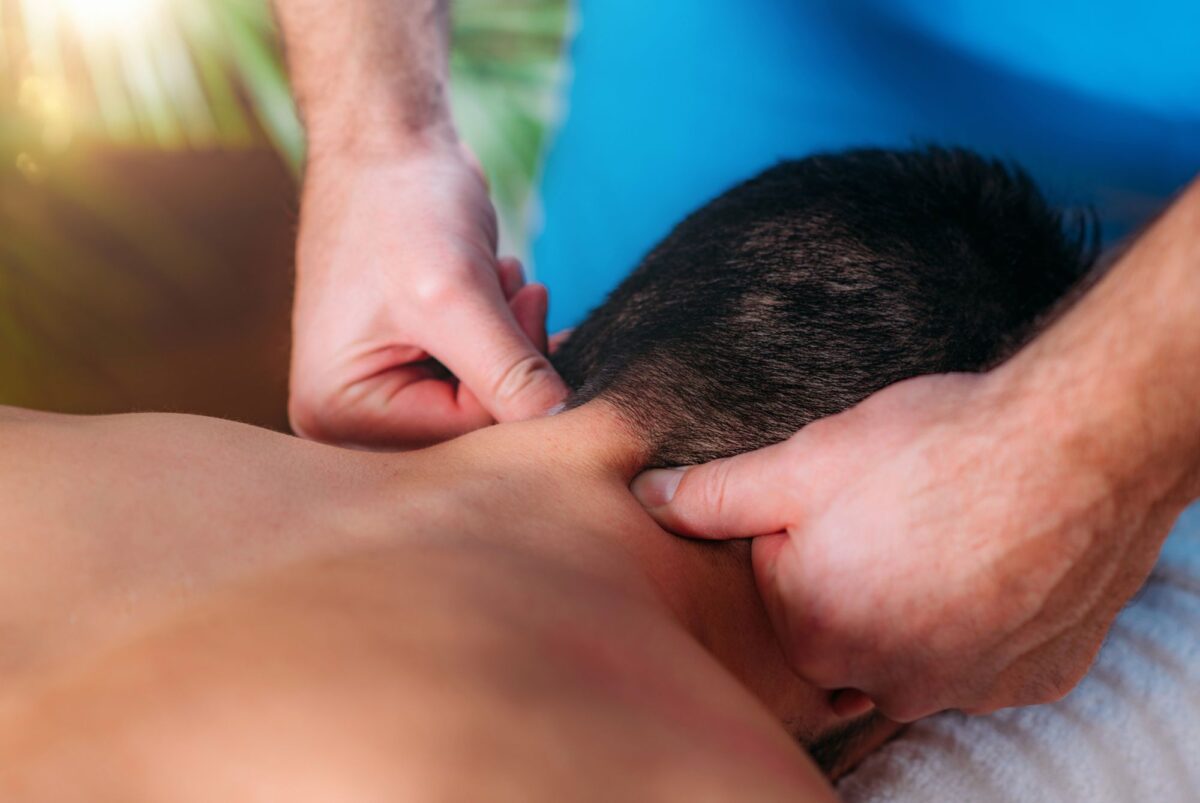
Neck pain can be caused by factors such as poor posture, muscle strain, injury, or an underlying health condition. Learn about how to get relief from neck pain.
Zac discusses osteoporosis causes, symptoms and treatment.
Brock, one of our accredited Back Program practitioners, explains sciatica pain and treatment.
Preparing for surgery can be a daunting and overwhelming experience. Whether you are facing a minor procedure or a major operation, it is natural to feel a range of emotions as you navigate the journey ahead. In this blog, we will explore strategies for preparing for surgery, as well as tips for managing the recovery process.
How can I prepare for surgery?
Regardless of the type of surgery you are about to undergo, the best course of action in the lead up is to follow the instructions provided by your doctor. This will outline when to stop eating and drinking before the procedure, and any medications to avoid.
In addition to this, you may like to consider implementing a proactive exercise program that can help improve the rate and success of recovery post-surgery. This process is referred to as ‘prehabilitation’ or ‘prehab’.
Studies have shown that by optimising a patient’s condition before surgery, prehabilitation can help reduce the risk of complications after surgery, reduce the recovery window, and improve overall quality of life. Prehab allows the patient’s muscles and joints to reach the best shape possible before surgery, kickstarting the rehabilitation process, speeding up recovery and stabilising pain. Prehabilitation programs can vary depending on the client’s needs and the type of surgery they are having. Generally clients will be prescribed a tailored exercise program to improve their strength, flexibility, and cardiovascular fitness. This can help them better tolerate the stress of surgery and recover more quickly afterward.
What will surgery involve?
This question is tricky to answer. The procedure will vary significantly, depending on the type of surgery being performed, the part of the body involved, and the patient’s overall health. The duration of a surgical procedure can also vary depending on the complexity of the operation and the patient’s overall health. Some surgeries are relatively short and can be completed in a few hours – such as appendectomy, knee reconstruction, and a mastectomy. Other more complex surgeries can take several hours or even days to complete.
Recovering from surgery
It’s important to recognise that everyone responds differently to surgery. Two people who undergo the exact same procedure may have vastly different recovery processes out the other side.
This can be influenced by a variety of factors, including:
Type of surgery: This is possibly the biggest determinant of the recovery window. Some surgeries may only require a few days of recovery, while others may require several weeks or even months.
Age: Younger people tend to recover faster from surgery than older adults. This is because younger people tend to have stronger immune systems, better circulation, and fewer chronic health conditions.
Overall health: Similar to the above, people who are in good overall health tend to recover more quickly from surgery than those who have underlying health conditions such as diabetes, heart disease, or cancer.
Lifestyle factors: Factors such as smoking, poor nutrition, and lack of exercise can slow down the recovery process.
Quality of post-operative care: The quality of care that a patient receives after surgery can also affect their recovery window. Patients who receive appropriate pain management, wound care, and exercise therapy tend to recover more quickly than those who do not.
Complications: The occurrence of complications such as infections, bleeding, or other medical issues can also prolong the recovery window.
Mental health: The mental health of the patient can also play a role in the recovery window. Patients who are anxious, depressed, or stressed may take longer to recover than those who are in a positive and relaxed state of mind.
Post-surgical rehabilitation
At Atkins Health, we regularly work with clients in the lead up to, and following, a surgical procedure. Implementing a tailored prehabilitation and rehabilitation plan gives the body the absolute best chance at bouncing back.
Our rehabilitation exercise plans incorporate a blend of movements tailored to address the area impacted by the surgery. This will typically include a variation of the following exercise types.
Range-of-motion exercises:
- Designed to improve flexibility and reduce stiffness.
- Example: knee bends and leg extensions may be prescribed to improve range of motion following knee surgery.
Strengthening exercises:
- Targetted to improve muscle strength and help patients regain functional abilities.
- Example: after shoulder surgery, exercises such as shoulder presses and bicep curls may be prescribed to strengthen the muscles around the shoulder joint.
Balance exercises:
- Commonly introduced to reduce the risk of falls by improving stability.
- Example: after hip surgery, the patient may be prescribed exercises such as standing on one leg and heel raises to improve their balance.
Cardiovascular exercises:
- These exercises can help improve cardiovascular health and endurance.
- Example: after heart surgery, the patient may be prescribed exercises such as walking, cycling, or swimming to improve their cardiovascular fitness.
Working with an experienced exercise physiologist can provide education and guidance on proper exercise form and technique. We also monitor your progress and adjust your program as needed to ensure that you are making steady progress towards your goals.
If you have an upcoming surgery, why not reach out to one of our exercise experts. We can guide you through a personalised exercise program to help you bounce back in your best shape possible.
Falling pregnant is an exciting time, but it can also open the door to a wave of new worries. Your body is going through a lot of change, and suddenly there is a whole list of do’s and don’ts to inform your daily habits.
Exercise in pregnancy is a confusing concept for many expectant mothers. Should you be exercising? What’s okay and what’s not? How does all this affect the baby?
Once, pregnant women were ordered on bed rest and told not to lift a thing. Fortunately, we now know this to be unnecessary as research points toward the benefits of exercise during pregnancy. In fact, the Australian Physical Activity and Sedentary Behaviour Guidelines for pregnancy are the same as those for non-pregnant adults.
However, that’s not to say that there won’t be certain precautions and modifications. Today we address your top questions on prenatal exercise.
What are the benefits of exercise during pregnancy?
Staying active during pregnancy can be highly beneficial for both you and your baby. Not only is it a great way to stave off boredom or restlessness, but it can also be a rewarding outlet for managing your mental health.
Benefits of exercising through pregnancy include:
- preparing the body for labour and recovery
- reducing back and pelvic pain
- lowering risk of incontinence
- bettering mental health, including a lower risk of postnatal depression
As your body undergoes many changes throughout pregnancy, it can trigger other conditions. Prenatal exercise programs have been shown to reduce the risk of developing conditions such as:
- Gestational diabetes
- Gestational hypertension
- Preeclampsia
- Excessive weight gain
The added bonus is that engaging in prenatal exercise classes can be a great way to meet new people going through a similar experience. Pregnancy, especially a first pregnancy, can be daunting and overwhelming. Exercise offers a chance to connect and destress while getting your body in the best possible state to welcome a new life.
What type of exercise is best during pregnancy?
The appropriate type of exercise for pregnant women will be different for every person. It will depend entirely on the exercise you were doing before falling pregnant. If you’re a gym goer 3-4 times a week, then this is perfectly fine to continue during pregnancy. If you’ve long been a runner, then keep at the tracks!
Over time, you’ll modify the exercises you’re doing and the intensity that they’re being performed based on the physical condition you’re in. The same goes for cyclists, yoga lovers, swimmers – whatever your typical medium of exercise may be.
If you’re someone who hasn’t exercised before, it is recommended that you start by doing some low intensity exercise, then slowly build up to the recommended amount. Prenatal pilates is a great place to start for pregnant women who haven’t exercised before. Prenatal pilates takes the gravity out of exercising, it’s lower impact, and uses a variation of movements. It incorporates strength training, aerobic training and stretching in a low impact environment.
The best prenatal exercises will depend on your own preference. Some of our favourites are:
- Strength training
- Pilates
- Yoga
- Hydrotherapy
- Walking
- Running
- Cycling
In a nutshell, when it comes to exercising through pregnancy, stick to what you know. Now is not the time to take up a running career or powerlifting for the first time.
Exercises to avoid during pregnancy
With all that being said, there are some movements that are best avoided during pregnancy. Be mindful of any sort of jumping or jarring activities. During pregnancy, the body releases hormones that loosen and relax your muscles, joints and ligaments to help the body stretch. This can make the body slightly more prone to injury. Care should be taken when stretching too, ensuring you do not go further than necessary.
Use common sense with activities that are going to be somewhat unsafe, in terms of fall risks and high impact. This might mean hanging up the snowboard or waterskis for a few months.
The Australian guidelines recommend avoiding activities that involve:
- High risk of falling or collision
- Intense straining while lifting
- Significant changes in pressure (such as sky diving or scuba diving)
How much should you exercise while pregnant?
Now that we’ve covered the ‘what’, let’s explore the ‘how much’. It’s true that too much of a good thing can equal a bad thing. But the good news is that the limit is far higher than we once thought.
The national guidelines suggest being active most days, preferably every day, to a weekly total of either:
- 2.5 to 5 hours of moderate-intensity physical activity
- 1.25 to 2.5 hours of vigorous-intensity physical activity
- an equivalent combination of moderate and vigorous activities.
The approach to exercising while pregnant can be viewed similarly to the approach to giving up alcohol; Before trying to fall pregnant, many women will give up alcohol to put their body in the best shape to welcome a new life. The same goes for exercising. We recommend getting your body into the best physical state that you can manage at that time. This gives your body the best chance to fall pregnant and have a healthy pregnancy while mitigating as many risks as possible.
If you still feel unconfident in your exercise routine or simply want an expert hand to guide you along the way, we are here to help.
Have you considered adding strength training to your program? Strength training works against resistance to improve the body’s ability to cope with everyday demands. It’s highly beneficial for clients of all ages and abilities – not just athletes! Here we explain why strength training is so popular among our exercise physiologists, and how it could benefit you.
What is strength training?
Strength training uses specific exercises that require the muscle to exert force against a form of resistance. This resistance can be anything from gravity to a barbell or resistance band. For this reason, strength training is often referred to as resistance training.
These exercises are designed to increase the strength, endurance and size of the targeted muscles. As the muscles work to overcome the resistance applied to them, they are progressively strengthened.
Strength training exercises are most effective when performed 2-3 times per week. We often incorporate various forms of strength training as part of our client’s holistic exercise plan.
Using resistance to strengthen the body
Strength training comes in many different forms and doesn’t always involve lifting the heaviest weights possible. Body weight alone can actually offer sufficient resistance to strengthen the body.
The right format of training will depend on the ability of the client and any underlying conditions or injuries we are working with. Common types of strength training include:
Body Weight
If you’ve ever attempted a pull up, you would be aware of the resistance your body weight provides when working against gravity. Body weight exercises are commonly used in strength training for their convenience and ability to target several muscle groups at once. Squats, push ups, chin ups and lunges are all common examples of body weight strength exercises.
Resistance Bands
We often use resistance bands in our physical therapy programs, but they’re also a great tool for strength training. Resistance bands make it easier to isolate and target specific muscles, compared to working with weights. They’re also easy to transport, so you can train anywhere, anytime.
Weights (Free Weights/Machines)
Weightlifting is most commonly associated with exercises for strength training. At Atkins, we work with a mix of free weights (dumbbells) and weight machines.
Pilates
Many of our clients are surprised to learn that pilates is a highly effective form of strength training. Although low impact, the practice of pilates requires precise, controlled movements that effectively strengthen smaller muscles that are often overlooked. Pilates is particularly effective in strengthening the deep muscles of the back, abdomen and pelvic floor – known as the core muscles. Core strength is foundational to overall body health and well-being.
Increasing strength for improved lifestyle
Strength training isn’t just about beefing up those muscles. As exercise physiologists, we’re big believers in the benefits of strength training programs that go beyond the surface. We’re talking about long term lifestyle enhancement that can transform an individual’s quality of life.
Benefits of strength training include:
- Improved balance and coordination
- Improved performance of everyday tasks
- Improved confidence and self esteem
- Improved cognitive function
- Improved independence
- Reduces symptoms of anxiety and depressions
- Helps prevent chronic conditions such as diabetes, heart disease, arthritis, and osteoporosis
- Decreased risk of injury
Building strength helps when managing injury
Strength training can be intimidating to newcomers. It’s a common misconception that resistance exercises are only for athletes or those working towards strict performance goals. At Atkins, we prescribe strength training exercises for clients from 15 years old through to 90+!
Improved strength helps make everyday activities easier, which may seem simple, but can make a huge difference for those managing injury or chronic health conditions. Whether your goal is to pick up your grandkids, walk your daughter down the aisle, or gain more independence in daily life – strength training can help.
Strength training is beneficial for:
- Cancer patients
- Surgery prehabilitation and rehabilitation
- Athletes
- Clients with chronic health conditions (Parkinson’s Disease, Arthritis, Osteoporosis)
Exercise physiologists work in cancer clinics to allow people going into treatment to leave in the same condition, if not better, as when they entered treatment. We do so by using strength training to maintain or improve physical capacity so clients may leave the program better for it.
Wondering if strength training is right for you? Why not arrange a personal consultation with one of our expert EPs to discuss how you can incorporate strength training into your lifestyle?
Sport is a great way for young children to stay active, healthy, and entertained, but did you know that sport has also been linked to improving engagement and performance at school? Physical activity has been shown to improve brain activity, which plays a pivotal role in a child’s development.
Not only is sport a fun and cost-effective way for children to develop physical, social, and emotional skills – but it can also help students build confidence, develop leadership skills, and improve their academic performance. We explore how sport is linked to childhood development, and how it could benefit your child to reach their full potential.
Developing skills for success in school and life
Executive functioning skills are a set of cognitive abilities that inform our behaviour and thought processes. They begin to develop gradually from childhood and continue right through to adulthood. Executive functioning skills allow us to focus attention, plan and prioritise tasks, remember instructions and follow through on them, regulate emotions, and inhibit impulses. These skills are essential for academic and personal success, and research has shown that regular exercise can enhance executive functioning skills.
The link between sport and executive functioning skills
We know that sport is great for physical development, but understanding its role in mental development is a little more complex. At a top level, exercise has been proven to improve brain function and enhance the growth of brain cells. When we exercise, the levels of neurotransmitters in the brain, including dopamine and serotonin, increase. These chemicals play a critical role in executive functioning skills, helping to regulate attention, motivation, and mood.
Regular exercise has also been linked to improved cognitive skills such as memory, attention, and decision-making. This helps children plan and organise their activities, prioritise tasks, and manage time effectively. Sport is a great way to get children involved in exercise while simultaneously fuelling their brain with everything it needs to develop and thrive.
When is the best time to get involved?
Executive functioning skills develop from childhood through adolescence and into adulthood, with the most rapid rate of development occurring in childhood and adolescence. These skills begin in children without the development of foundational executive functioning skills such as impulse control, attention, and working memory. The rate of development is influenced by genetic and environmental factors, such as exposure to stress, nutrition, and sleep.
Exercise programs introduced between the ages of 5 – 14 years have shown to be particularly beneficial for developing key executive functioning skills. Specialised programs can help create a supportive and structured environment for children to practise, while modelling positive behaviours through exercise.
Atkins’ My Strong Kids Program
My Strong Kids is Atkins Heath’s specialised exercise program. It uses play and games that kids love to help improve executive functioning skills. Tailored to suit children up to Years 7 & 8, the program is ideal for all kids, including those with learning and physical difficulties.
Our team of expert exercise physiologists is experienced in working with children with:
- ASD – Autism Spectrum Disorder
- ADHD – Attention Deficit Hyperactivity Disorder
- Spina Bifida
- Cerebral Palsy
Our programs are designed to offer a fun, exciting environment for kids to develop key life skills. Each session will typically begin with a warm-up before moving into a strength program specifically designed to help develop:
- Impulse control
- Emotion control
- Organisation
- Working memory
- Task initiation
- Flexible thinking
- Self-monitoring
- Planning
We conduct regular comprehensive assessments of special tests related to youth development. This helps us understand individual needs and monitor each student’s unique progress.
Get in touch to find out how exercise can help unlock your child’s full potential.

